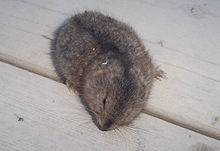North American brown lemming
| North American brown lemming | |
|---|---|
 |
|
| North American brown lemming, young | |
| Scientific classification | |
| Kingdom: | Animalia |
| Phylum: | Chordata |
| Class: | Mammalia |
| Order: | Rodentia |
| Family: | Muridae |
| Genus: | Lemmus |
| Species: | L. trimucronatus |
| Binomial name | |
|
Lemmus trimucronatus (Richardson, 1825) |
|
 |
|
| North American brown lemming range | |
The North American brown lemming (Lemmus trimucronatus) is a small North American lemming. Originally called the Siberian brown lemming (Lemmus sibiricus) they were later formed into two distinct species.
The lemmings are a brown in colour, with an reddish-brown back and rump, while the head and shoulders are grey. In the winter, the coat becomes longer and greyer. The female averages 12.5 cm (5.7 in) in length and weighs 58 g (2.4 oz), while the male averages 13 cm (5.9 in) and weighs 68 g (2.7 oz). Like other lemmings, it has small ears, short legs and a very short tail. The feet, both the soles and toes, are covered with bristles and are adapted for burrowing.
The lemming is found in the tundra areas of northern Canada (Nunavut, Northwest Territories, Yukon), and Alaska. It is also found on the west coast of British Columbia almost as far south as Vancouver Island. They feed mainly on grass shoots and will also eat tundra grass, sedge, moss, bark, berries, lichens, and roots. Predators include most carnivores and certain birds, and some evidence suggests caribou may sometimes eat them. In years when the brown lemming is scarce, some predators, such as the Arctic fox, may be unable to reproduce.
They live underground, in colonies, and may produce up to three litters each year, including under the snow in winter. With a gestation period of 23 days, the female will give birth from four to nine young. The brown lemming is not migratory and when overpopulated (and during mating season), they will fight amongst themselves.
...
Wikipedia

